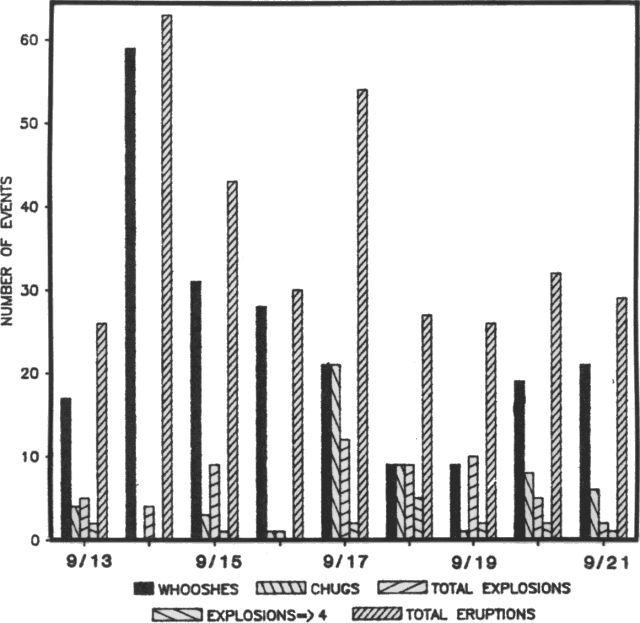Report on Arenal (Costa Rica) — September 1988
Scientific Event Alert Network Bulletin, vol. 13, no. 9 (September 1988)
Managing Editor: Lindsay McClelland.
Arenal (Costa Rica) Explosive activity documented
Please cite this report as:
Global Volcanism Program, 1988. Report on Arenal (Costa Rica) (McClelland, L., ed.). Scientific Event Alert Network Bulletin, 13:9. Smithsonian Institution. https://doi.org/10.5479/si.GVP.SEAN198809-345033
Arenal
Costa Rica
10.463°N, 84.703°W; summit elev. 1670 m
All times are local (unless otherwise noted)
From 13 to 21 September, the number, type, and estimated magnitudes of Arenal's Vulcanian eruptions were continuously noted by volunteers from the Smithsonian Research Expedition Program. Because of poor summit visibility, eruption type was recognized by sound signature. Eruptions (figure 18) consisted of explosions, intense block and bomb fountains (identified by "whooshing" sounds), and smaller rhythmic block and bomb fountains (weak "chugging" noises at ~1- to 2-second intervals). The eruption rate varied greatly but averaged 1.5/hour. Seismic energy release was greatest for intense block and bomb fountaining and much less for explosions. The frequency of explosions continued a 2-year decline, but intense fountains of bombs, blocks, and ash continued to increase in number. At 0910 on 17 September, a fountaining episode produced a hot fallback avalanche (~60,000 m3) that descended to 1.5 km S of the summit crater. Explosions ejected incandescent, highly phyric, viscous, basaltic andesite bombs and blocks to ~650 m from the crater, and rarely to 1 km. No lava flows were emitted.
 |
Figure 18. Number and type of emissions from Arenal's summit cone, 13-21 September, 1988. Courtesy of W. Melson. |
The activity continued to build a new cone (over Crater C) that reached 1,550 m elevation about 350 m W of the old summit cone, inactive except for numerous fumaroles. The old cone's walls, 1,633 m high prior to the 1968 eruption, continued to collapse, largely due to ballistic impacts from the explosions.
Acid rain within 2.5 km of the summit had pH values as low as 3.4. During the mid-September observations, the winds were typically from the W, contrary to the normal easterly trade winds. Ash frequently fell to the E, including the town of La Fortuna.
The Univ of Costa Rica reported that an average of 15 explosions were registered/day during the last week in September. The two main summit area fumaroles emitted gas that was predominantly white (water vapor) but included some basal bluish coloration, probably from sulfur compounds or chlorine.
Geological Summary. Conical Volcán Arenal is the youngest stratovolcano in Costa Rica and one of its most active. The 1670-m-high andesitic volcano towers above the eastern shores of Lake Arenal, which has been enlarged by a hydroelectric project. Arenal lies along a volcanic chain that has migrated to the NW from the late-Pleistocene Los Perdidos lava domes through the Pleistocene-to-Holocene Chato volcano, which contains a 500-m-wide, lake-filled summit crater. The earliest known eruptions of Arenal took place about 7000 years ago, and it was active concurrently with Cerro Chato until the activity of Chato ended about 3500 years ago. Growth of Arenal has been characterized by periodic major explosive eruptions at several-hundred-year intervals and periods of lava effusion that armor the cone. An eruptive period that began with a major explosive eruption in 1968 ended in December 2010; continuous explosive activity accompanied by slow lava effusion and the occasional emission of pyroclastic flows characterized the eruption from vents at the summit and on the upper western flank.
Information Contacts: W. Melson, SI; G. Soto, Univ de Costa Rica.

